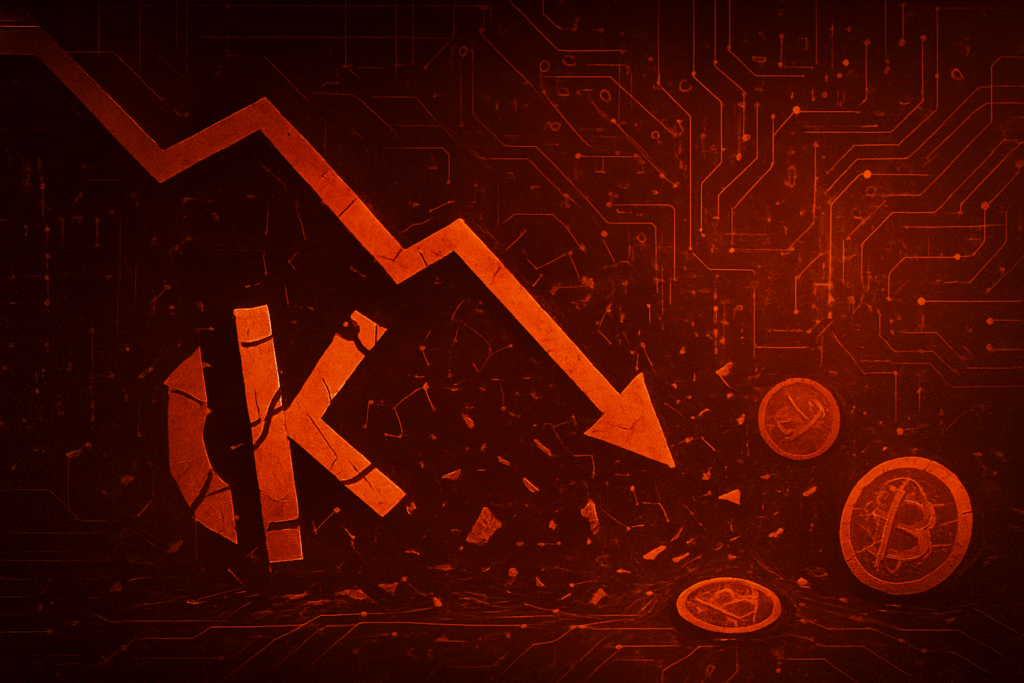
October 23, 2025 – The cryptocurrency world was rocked this week by the dramatic announcement that Kadena, the blockchain company behind the KDA token, is ceasing all business operations and active maintenance of its network. This abrupt shutdown, attributed to "unfavorable market conditions" and a lack of a "viable short-term trajectory," triggered a catastrophic 65% plunge in the KDA token's value within hours, sending shockwaves through its community and the broader crypto ecosystem. Major exchanges, including OKX and Bybit, swiftly moved to delist KDA, further exacerbating the crisis and raising critical questions about project viability and investor trust in the volatile digital asset space.
The news, initially disseminated via an official post on X (formerly Twitter) on October 21st or 22nd, 2025, left investors reeling. While Kadena's core team emphasized that the underlying proof-of-work blockchain is designed to continue operating as a decentralized entity, maintained by independent miners and developers, the cessation of corporate backing marks a significant blow. This event serves as a stark reminder that even technically ambitious projects, backed by experienced founders, are not immune to the harsh realities of market dynamics and the imperative for sustained adoption.
Market Impact and Price Action
The immediate market reaction to Kadena's shutdown announcement was nothing short of devastating for KDA holders. From trading around $0.20 just prior to the news, the KDA token plummeted to levels below $0.10, and in some instances, as low as $0.065, representing a single-day decline of approximately 60-70%. This precipitous fall compounded an already significant monthly decline of 77% leading up to the announcement. More broadly, the token's post-crash value signifies a staggering loss of over 99% from its all-time high of $27.64, achieved during the bullish market of November 2021.
The market capitalization of Kadena, which once soared near $4 billion, dwindled to a mere $26-28.8 million in the wake of the news, effectively wiping out nearly all accumulated value. Trading volume initially surged by over 1,277% to $105.3 million within 24 hours, indicative of a panicked sell-off as investors scrambled to liquidate their positions. However, this surge was quickly followed by a sharp liquidity crunch as major centralized exchanges initiated delisting procedures. OKX announced the suspension of KDA deposits on October 22nd, with plans to halt Buy/Sell and Convert services by October 26th and remove all KDA trading pairs (KDA/USDT and KDA/USDⓈ) by October 29th. Bybit (BYBIT) similarly moved to delist its KDAUSDT perpetual contract and discontinue KDA as a collateral and lending asset by October 24th. While withdrawals from OKX are set to remain open until January 22, 2026, these actions severely restrict market access and further dampen any prospects of price recovery.
The decentralized finance (DeFi) ecosystem built on Kadena also suffered a severe blow. The Total Value Locked (TVL) on Kadena plummeted by 71% in a single day, falling to a meager $128,000 from its peak of $11 million in August 2022. Key protocols like Kadena Cabinet saw over 70% of their TVL disappear, while decentralized exchanges such as KDSwap and Mercatus experienced liquidity declines of 83% and 64%, respectively. This rapid evaporation of liquidity increases slippage risks for any remaining traders and effectively cripples the network's DeFi capabilities.
Historically, Kadena launched its mainnet in January 2020, founded by former JPMorgan (NYSE: JPM) engineers, and boasted a "braided chain" architecture promising high transaction throughput (up to 480,000 transactions per second) and a secure smart contract language called Pact. Despite launching a $100 million developer grant program in 2022 to foster ecosystem growth, Kadena struggled to achieve sustained user adoption and developer traction, ultimately leading to its current predicament.
Community and Ecosystem Response
The news of Kadena's shutdown sent a palpable wave of frustration and anger through the crypto community, particularly across social media platforms like X and Reddit. Many long-term holders expressed a profound sense of betrayal, with some even likening the sudden cessation of operations to an "exit scam," though no evidence has been presented to support such claims. Initial confusion regarding the authenticity of the announcement on X was quickly dispelled when the Kadena team confirmed the shutdown on its official Discord channel, clarifying it as an organizational exit rather than a chain halt.
While a significant portion of the community reacted with panic selling and accusations, a smaller segment held onto the hope that the decentralized nature of the underlying blockchain would allow it to persist under community and miner governance, drawing parallels to Bitcoin's self-sustaining model. However, the overall sentiment reflected a significant erosion of investor confidence and a bleak outlook for the token's long-term health without the backing of its founding entity. On-chain data revealed a 40% decrease in active addresses, further indicating a rapid decline in community engagement.
Among crypto influencers, a notable reaction came from Charles Hoskinson, founder of Cardano (ADA). Hoskinson publicly reached out to the Kadena community on X, signaling a willingness to engage in discussions regarding potential support or collaboration. This overture sparked speculation about a possible partnership or a new lease on life for the struggling chain, though concrete plans remain unconfirmed.
The impact on Kadena's nascent ecosystem of DeFi protocols, NFT projects, and Web3 applications has been severe. As detailed above, the TVL in DeFi has collapsed, rendering many protocols effectively non-functional due to a lack of liquidity. Kadena had developed its own poly-fungible NFT standard, KIP-0011, and projects like Kadena Mining Club (KMC) utilized NFTs for fractionalized investments. However, the absence of the core development team is expected to severely impact the growth and viability of these projects, as developers and users seek more stable environments. Similarly, Web3 applications that aimed to leverage Kadena's infrastructure-grade performance and developer-friendly Pact language are now left without core support, making future innovation and adoption highly unlikely.
What's Next for Crypto
Kadena's dramatic collapse, occurring just as the crypto market navigates a complex period of recovery and regulatory evolution, carries significant short and long-term implications for the wider ecosystem. In the immediate future, we can expect heightened investor caution and a dampening of sentiment, particularly towards smaller, less-established Layer-1 blockchain projects. This "flight to quality" could see capital further consolidating into more mature and liquid assets like Bitcoin (BTC) and Ethereum (ETH), while other alternative Layer-1s facing similar adoption challenges may experience increased investor skepticism and selling pressure.
Looking ahead, Kadena's shutdown signals a potential "shakeout" within the industry, particularly among the numerous Layer-1 solutions that have emerged in recent years. This event underscores that technical innovation alone is insufficient; a sustainable business model, robust ecosystem development, and genuine user adoption are paramount for long-term viability. Projects that fail to achieve product-market fit or sustain development through prolonged bear markets will likely face similar fates. This could lead to a more consolidated and mature crypto landscape, albeit with fewer, but stronger, foundational networks. Furthermore, the failure of a project with institutional backing could draw increased attention from regulators, potentially leading to calls for stricter oversight on fundraising, project viability, and investor protection.
For projects, the strategic considerations are clear: prioritize sustainable business models, focus relentlessly on product-market fit and user adoption, and actively foster true decentralization and community empowerment to reduce reliance on a single corporate entity. For investors, the lessons are equally vital: conduct rigorous due diligence beyond whitepapers and hype, diversify portfolios, understand and manage risk, and prioritize projects with clear utility, sustainable economics, and a demonstrated ability to attract and retain users and developers.
Possible scenarios for the broader market include an "isolated incident" (moderate likelihood), where Kadena's failure is seen as unique to its challenges. However, a "market consolidation" for alt-L1s (high likelihood) seems more probable, leading to more projects struggling or failing. A "regulatory clampdown" (moderate to high likelihood) is also a strong possibility, as regulators often react to significant market events. A "successful community revival" of Kadena (low likelihood) remains a distant hope, given the immense challenges of sustaining development and adoption without core funding and a dedicated team.
Bottom Line
The sudden and dramatic collapse of Kadena (KDA) serves as a stark, undeniable reminder of the inherent risks and rapid evolutionary pace within the cryptocurrency market. For crypto investors and enthusiasts, the key takeaways are manifold. First, rigorous due diligence is non-negotiable; understanding a project's team, funding runway, tokenomics, developer activity, and actual user adoption metrics is far more crucial than relying solely on technological claims or market hype. Second, diversification remains a cornerstone of prudent investment strategy, mitigating the impact of any single project's failure.
The long-term significance of Kadena's shutdown lies in its potential to accelerate the industry's maturation process. It emphasizes that while decentralization is a core tenet, many projects still rely heavily on centralized entities for their growth and sustenance. Investors must critically assess the true degree of decentralization and a project's ability to thrive independently. This event will likely prompt a re-evaluation of what constitutes a "viable" blockchain project, shifting focus towards those with proven utility, robust ecosystems, and a clear path to self-sustainability.
As of October 23, 2025, the Kadena saga continues to unfold. Important dates to monitor include the final delisting of KDA trading pairs from OKX by October 29th and the cessation of Bybit's services by October 24th. While the Kadena team aims to release a new binary to enable autonomous network operation, the future of the decentralized chain now rests solely in the hands of its community and independent miners. This pivotal moment underscores the need for continuous monitoring of market health, regulatory developments, and the resilience of community-driven initiatives in a landscape where only the most robust and adaptive projects are likely to endure.
This article is for informational purposes only and does not constitute financial or investment advice. Cryptocurrency investments carry significant risk.





